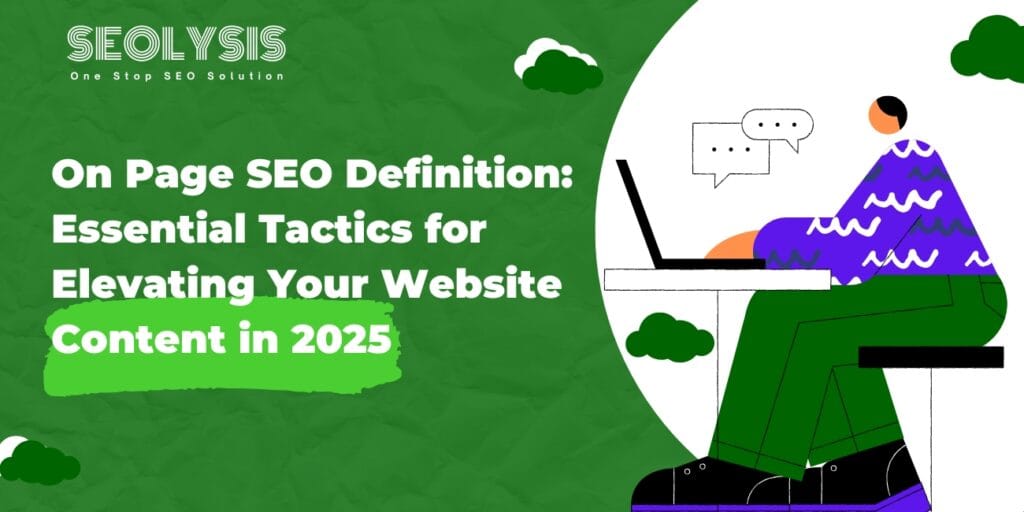
Unlock the Secrets of On Page SEO Today!
In the ever-evolving landscape of digital marketing, understanding the intricacies of search engine optimization (SEO) is essential for anyone looking to enhance their online presence. One of the foundational elements of SEO is on-page optimization, which focuses on the strategies and techniques applied directly within the content of a webpage. But what exactly is on-page SEO? This article delves into the on-page SEO definition, exploring its significance and highlighting key strategies for optimizing website content to improve visibility and rankings in search engine results. Whether you’re a seasoned marketer or just starting out, grasping these concepts can empower you to create compelling content that resonates with both users and search engines alike.
Importance of On-Page SEO for Improving Search Engine Rankings
On-page SEO refers to the various strategies and techniques that can be employed directly on a webpage to enhance its visibility in search engine results. The on page seo definition encompasses a range of factors, from content quality to HTML tags, which play a significant role in determining how well a page ranks. By optimizing individual pages, website owners can improve their chances of attracting organic traffic, ultimately leading to higher conversion rates and better user engagement.
One of the critical aspects of on-page SEO is the optimization of content. This involves ensuring that the content is relevant, valuable, and tailored to the needs of the target audience. By conducting thorough keyword research and seamlessly integrating keywords into the content, headings, and meta descriptions, website owners can signal to search engines what topics their pages are covering. Additionally, high-quality content that answers user queries tends to keep visitors on the page longer, reducing bounce rates and increasing the likelihood of earning backlinks from other sites.
Another important element of on-page SEO is the technical structure of a webpage. This includes the use of proper HTML tags, alt text for images, URL structure, and mobile responsiveness. Search engines rely on these technical signals to crawl and index web pages accurately. A well-structured website not only helps search engines understand the content but also enhances the user experience. Easy navigation and quick loading times foster positive engagement, which can further boost rankings in search results.
In conclusion, on-page SEO is a foundational component of any successful digital marketing strategy. By understanding the on page seo definition and implementing best practices, businesses can greatly improve their search engine rankings and overall online presence. As digital environments become increasingly competitive, mastering on-page SEO is essential for attracting and retaining audience attention, thereby driving growth and success in the online marketplace.
Understanding On-Page SEO: A Comprehensive Guide
On-page SEO refers to the various elements within your website that you can optimize to improve its visibility and relevance in search engine results. Understanding on-page SEO is essential for any website owner or digital marketer, as it directly influences how your content is interpreted by search engines like Google. The on page seo definition encompasses a wide range of factors, including the quality of your content, the strategic use of keywords, and the proper formatting of headings and meta tags. By focusing on these foundational aspects, you can significantly enhance your site’s performance and user experience.
One of the primary components of on-page SEO is keyword optimization. This involves researching and selecting the right keywords that your target audience is searching for and then integrating those keywords naturally into your content. Keeping user intent in mind is crucial; you want your content not only to rank well but also to meet the needs of those searching. Additionally, the structure of your content plays a vital role. Utilizing headings, bullet points, and short paragraphs improves readability, allowing visitors to digest information more easily. This, in turn, can decrease bounce rates, which is a factor that search engines consider when ranking pages.
Another important aspect of on-page SEO is the technical optimization of your pages. This includes ensuring that your website loads quickly, is mobile-friendly, and utilizes proper tagging for images and links. Image optimization, for instance, can be achieved by compressing files to improve load times and using descriptive alt text to enhance accessibility. Furthermore, internal linking strategies can help guide users to related content within your site, encouraging longer dwell times and improving the overall authority of your pages.
Ultimately, mastering on-page SEO is a continuous process of analysis and adaptation. Regularly updating your content based on performance metrics and emerging trends can help you maintain a competitive edge in search engine rankings. By understanding the various elements that contribute to on-page SEO, you will not only improve your site’s visibility but also create a better overall experience for your visitors, fostering trust and engagement with your brand.
Best Practices for On-Page SEO Optimization
On-page SEO refers to the practice of optimizing individual web pages to rank higher and earn more relevant traffic in search engines. The on-page SEO definition encompasses various elements, including content quality, keyword optimization, and user experience. By focusing on these components, businesses can enhance their online presence and improve their search engine rankings significantly. A well-optimized page not only attracts search engine crawlers but also engages readers, encouraging them to stay longer, consume content, and convert.
One of the most crucial aspects of on-page SEO is keyword research. Identifying the right keywords to target ensures that your content aligns with user intent. By strategically placing these keywords throughout your content—in headings, subheadings, and within the body paragraphs—you create a seamless flow that helps search engines understand the page’s relevance. However, it’s vital to maintain a natural tone, avoiding keyword stuffing, which can lead to penalties from search engines. Utilizing synonyms and related terms can further enhance the content’s depth and relevance.
Another best practice involves optimizing title tags and meta descriptions. These elements are often the first touchpoint potential visitors have with your content on search engine results pages (SERPs). A compelling title tag, supplemented by a clear and enticing meta description, can dramatically increase the click-through rate, drawing more traffic to your site. Additionally, leveraging header tags (H1, H2, H3) to structure your content makes it easier for search engines and users to navigate, improving overall usability.
Lastly, incorporating multimedia elements like images, videos, and infographics can significantly enhance user engagement and lower bounce rates. When optimizing these elements, it’s important to use appropriate alt attributes and file names, as these practices contribute positively to both user accessibility and on-page SEO. By embracing these strategies, website owners can create a more effective and engaging web presence that not only meets search engine algorithms but also resonates with their audience.

On-Page SEO Techniques to Enhance Website Visibility
On-page SEO is a critical component of search engine optimization that focuses on optimizing individual web pages to rank higher and earn more relevant traffic in search engines. The on page seo definition encompasses various elements within the content itself, such as the use of strategic keywords, meta tags, and high-quality multimedia to improve the user experience and engagement. By ensuring these elements are aligned with both user intent and search engine algorithms, you can significantly enhance your website’s visibility in search results.
One of the most important techniques in on-page SEO is the strategic use of keywords throughout your content. This involves identifying relevant keywords that potential visitors might use to find your content and incorporating them naturally into titles, headings, and body text. Moreover, attention should be paid to optimizing meta tags, including title tags and meta descriptions, which not only help with SEO but also serve as the first impression for users in search listings. Compelling and concise meta descriptions can entice users to click on your link, improving your click-through rate and further boosting your SEO performance.
Another vital aspect of on-page SEO is the optimization of images and multimedia. Search engines cannot interpret the content of images in the same way humans can, so using alt tags that describe your images can ensure that you don’t miss out on valuable traffic from image searches. Additionally, implementing headings and subheadings effectively can help structure your content, making it easier for both users and search engines to navigate. This organization also enhances the readability of your content, encouraging visitors to stay on your site longer, which can positively influence your search rankings.
Lastly, ensuring that your website is mobile-friendly and has fast loading speeds is essential for a successful on-page SEO strategy. With an increasing number of users accessing websites via mobile devices, having a responsive design can significantly enhance the user experience. Similarly, a site that loads quickly will prevent users from bouncing back to search results, thus signaling to search engines that your site delivers quality content. By combining these on-page techniques, you can effectively enhance your website’s visibility and attract more targeted traffic, ultimately contributing to the success of your online presence.
The Role of Keywords in On-Page SEO Strategy
Keywords are a fundamental component of any effective on-page SEO strategy. They serve as the bridge between what users are searching for and the content that websites provide. To maximize visibility in search engine results, it is essential for website owners and content creators to understand how to implement keywords effectively. This begins with a solid on-page SEO definition, which focuses on optimizing individual pages on a website to rank higher and earn more relevant traffic from search engines. This includes not only the content itself but also elements like meta tags, headers, and URL structures.
Incorporating relevant keywords is paramount to ensuring that search engines can interpret the content of a page effectively. High-quality, keyword-rich content enables search engines to determine the relevance of a page to specific queries. This involves strategic placement of primary and secondary keywords within the content, as well as using variations and long-tail keywords that may attract more specific search traffic. Additionally, these keywords should be woven seamlessly into the flow of the text to maintain readability while still targeting search intent.
Moreover, attention should be paid to on-page elements such as title tags, alt attributes for images, and internal linking strategies. Title tags are crucial for conveying the essence of a page, and including keywords here can significantly enhance click-through rates. Alt attributes not only improve accessibility but also provide additional opportunities to include keywords that describe an image’s content. Internal links, when used thoughtfully, can distribute page authority across a website while also enhancing user navigation. All these aspects should align with a cohesive keyword strategy that addresses both user intent and search engine algorithms.
Ultimately, the role of keywords in an on-page SEO strategy extends beyond mere placement. It requires continuous analysis and adaptation to evolving search trends and consumer behavior. By regularly updating content to reflect changing keyword relevance and integrating analytics tools to monitor performance, website owners can ensure that their on-page efforts yield long-term benefits. This dynamic approach to keyword utilization not only improves rankings but also enriches user experience, establishing a website as a trustworthy source of information in its niche.
Enhancing User Experience through On-Page SEO
In the fast-paced digital landscape, enhancing user experience has become a cornerstone for successful online presence. One of the most effective ways to achieve this is through on-page SEO, a practice that not only improves a website’s visibility in search engines but also significantly impacts how users interact with content. On-page SEO refers to the optimization techniques applied directly to web pages, including elements such as content, HTML tags, and internal links. As search engines become increasingly sophisticated, delivering a positive user experience can mean the difference between retaining visitors and seeing them bounce to competitors.
To begin with, understanding the on-page SEO definition is essential for any website owner or content creator aiming to boost engagement. This practice involves ensuring that each page is optimized for relevant keywords while also being structured to meet the needs and expectations of users. High-quality content that addresses users’ queries, incorporates multimedia elements, and boasts a clear and logical layout can significantly enhance the overall user experience. Moreover, deploying targeted keywords naturally within titles, headers, and body text makes it easier for both users and search engines to grasp the page’s relevance.
Another vital aspect of on-page SEO is site speed and mobile responsiveness. Today’s users demand immediate access to information, and pages that load slowly or do not display well on mobile devices can lead to frustration and abandonment. Implementing techniques such as image optimization, reducing server response time, and leveraging browser caching are critical to fostering a seamless experience. Furthermore, organizing content in a user-friendly manner through proper headings and bullet points not only aids readability but also encourages users to stay longer, decreasing bounce rates—a metric closely monitored by search engines.
Finally, the integration of effective internal linking strategies serves to enhance user experience and strengthen the site’s structure simultaneously. By linking to relevant content within the site, users are guided through a coherent journey, encouraging them to explore further while also signaling to search engines the importance of the interconnected pages. This nuanced approach not only optimizes web pages for search engines but also prioritizes the user experience, creating a win-win scenario that can lead to better rankings and improved user satisfaction. In today’s competitive online ecosystem, understanding and implementing on-page SEO is not just beneficial—it’s essential for long-term success.
On-Page SEO Checklist: Steps for Success
On-page SEO is a critical aspect of digital marketing that focuses on optimizing individual web pages to improve their search engine rankings and attract more relevant traffic. The on-page SEO definition encompasses a variety of techniques aimed at enhancing both the content and HTML source code of a page. By ensuring that each page is properly optimized, marketers can significantly increase their visibility in search engine results, leading to greater user engagement and conversion rates.
To begin with, one of the essential steps in your on-page SEO checklist is to conduct thorough keyword research. Identifying the right keywords and phrases that potential visitors are using to find content similar to yours is imperative. Once you’ve determined your target keywords, strategically incorporate them into critical on-page elements such as the title tag, meta description, headers, and throughout the body content. However, it’s essential to maintain a natural flow and avoid keyword stuffing, as this can lead to penalties from search engines.
In addition to keyword optimization, content quality plays a vital role in on-page SEO. Creating high-quality, informative, and engaging content not only helps in attracting visitors but also encourages them to spend more time on your site, reducing the bounce rate. Utilizing multimedia elements such as images, videos, and infographics can further enhance user experience and boost the page’s SEO performance. Additionally, ensure that all multimedia is optimized with relevant alt tags and descriptions to help search engines understand their context.
Lastly, don’t overlook the significance of technical aspects like page speed, mobile optimization, and internal linking. Fast loading times and a mobile-friendly design are crucial for retaining visitors and improving rankings. Incorporating internal links not only aids in site navigation but also distributes page authority across your website, further elevating your chances of ranking higher in search engine results. By meticulously following this on-page SEO checklist, you can set a solid foundation for your website’s success in attracting and retaining organic traffic.
Measuring On-Page SEO Performance: Metrics to Track
Measuring on-page SEO performance is crucial for understanding how effectively your website is optimized for search engines and user experience. On-page SEO refers to the practices that are carried out directly on the site itself, such as content quality, keyword optimization, and user engagement strategies. By tracking specific metrics, website owners can evaluate the effectiveness of their on-page SEO strategies and make data-driven decisions for improvement.
One of the key metrics to consider is organic traffic, which indicates the number of visitors coming to your site through search engines. An increase in organic traffic generally signifies that your on-page SEO efforts are resonating with users and search engine algorithms alike. Additionally, analyzing keyword rankings will help you gauge how well your content is performing for specific search queries. Tools like Google Search Console can provide insights into which keywords are driving traffic to your pages and where there might be opportunities for further optimization.
Another vital aspect is the engagement metrics, such as bounce rate, average session duration, and pages per session. These metrics highlight how users interact with your content and can indicate whether your on-page SEO strategies are effectively attracting and retaining visitors. A high bounce rate may suggest that your content is not aligning with user intent or that the page layout could be refined to enhance the user experience. Monitoring conversion rates tied to specific pages can also illuminate how well your on-page SEO and overall content strategy are turning visitors into customers.
Finally, page speed and mobile-friendliness are increasingly important metrics to track. With Google’s emphasis on mobile-first indexing and user experience, optimizing for these factors can significantly affect your search rankings. Ensuring that your pages load quickly and are accessible on various devices not only improves your on-page SEO standing but also creates a better experience for your visitors. By comprehensively measuring these metrics, you can continuously refine your on-page SEO strategies and work towards improved rankings and user satisfaction.
Common On-Page SEO Mistakes to Avoid
When it comes to enhancing your website’s visibility on search engines, understanding on-page SEO is crucial. On-page SEO definition encompasses the various practices that can be performed directly on your web pages to improve their ranking. Despite knowing this, many website owners still fall into common pitfalls that can hinder their SEO efforts. One of the most prevalent mistakes is neglecting title tags. Title tags are often the first point of contact for potential visitors, and failing to include relevant keywords or crafting unengaging titles can result in missed opportunities. Each page should have a unique and compelling title that accurately reflects its content while incorporating target keywords.
Another frequent oversight is the lack of proper header tag usage. Headers (H1, H2, H3) help to structure your content, making it easier for search engines to understand the hierarchy and relevance of information. Misusing or omitting header tags can dilute the effectiveness of your content and confuse both visitors and search engines. Additionally, many sites overlook the impact of meta descriptions. A well-crafted meta description serves as a pitch to entice users to click through to your site. Not only should it include essential keywords, but it also needs to be succinct, informative, and engaging to increase your click-through rates.
Moreover, content quality and keyword stuffing remain significant issues in on-page SEO. While it is essential to optimize content with relevant keywords, overstuffing it can lead to penalties from search engines, as it often makes the content unreadable. Instead, focus on creating high-quality, informative content that naturally incorporates keywords. Additionally, many websites fail to optimize images, missing out on valuable opportunities to enhance user experience and improve loading times. Properly formatted alt text for images can boost SEO and accessibility, which is often overlooked in the pursuit of a visually attractive site.
In conclusion, being aware of these common on-page SEO mistakes can significantly influence your website’s performance. By understanding the on-page SEO definition and implementing best practices, you can improve your site’s chances of ranking higher in search engine results. Taking the time to refine title tags, header tags, meta descriptions, and content quality will not only foster better search engine rankings but also create a more engaging experience for your visitors.
Implementing On-Page SEO: Practical Tips for Success
Implementing on-page SEO is an essential strategy for improving your website’s visibility in search engine results. At its core, on-page SEO refers to the techniques and practices used to optimize individual web pages to rank higher and earn relevant traffic. The on-page SEO definition encompasses various elements such as title tags, meta descriptions, headers, and the overall content structure, all of which play a critical role in how search engines interpret your site. By focusing on these aspects, you can enhance both user experience and search engine crawlability, leading to better rankings and more organic traffic.
One of the most practical tips for successful on-page SEO is to conduct thorough keyword research. Identifying the right keywords that align with your audience’s search intent is key. Once you’ve pinpointed these target keywords, strategically place them throughout your content, including in headings, first paragraphs, and naturally throughout the body text. However, it is crucial to avoid keyword stuffing—using too many keywords can harm your rankings rather than help them. Instead, aim for a natural and informative flow that incorporates these terms seamlessly, while still providing valuable content to the reader.
In addition to keyword optimization, it’s important to focus on other on-page elements. Crafting compelling meta titles and descriptions is vital, as these snippets often make the first impression on potential visitors when they see your site in search results. Your title should accurately reflect the content while encouraging clicks, and descriptions should provide a concise summary that entices users to read more. Additionally, using descriptive alt text for images not only aids in accessibility but also gives search engines more context about your content.
Lastly, page speed and mobile-friendliness are indispensable factors in on-page SEO. With the rise of mobile browsing, having a responsive design ensures that your website performs optimally across devices. Pages that load quickly improve user experience and reduce bounce rates, signaling to search engines that your site is valuable. Tools like Google PageSpeed Insights can help you analyze and enhance your site’s performance. By integrating these practical tips into your on-page SEO strategy, you can create a solid foundation that supports organic growth and long-term success.
Recent Posts
- Breaking the Silos: A Fresh Blueprint for Integrated Marketing Success in 2025
 Discover a fresh blueprint for integrated marketing success in 2025. Break the silos and achieve seamless strategies with expert insights from Seolysis.
Discover a fresh blueprint for integrated marketing success in 2025. Break the silos and achieve seamless strategies with expert insights from Seolysis. - Trusted SEO Services in India: Unlock Your Business Growth
 Trusted SEO Services in India to elevate your online presence. Get higher rankings, more traffic, and sustainable growth. Contact us today!
Trusted SEO Services in India to elevate your online presence. Get higher rankings, more traffic, and sustainable growth. Contact us today! - How to Improve Website Traffic: Tips and Tricks
 Discover How to Improve website traffic. Learn proven strategies to attract more visitors and enhance your online presence.
Discover How to Improve website traffic. Learn proven strategies to attract more visitors and enhance your online presence. - SEO for Small Businesses: Why Investment is Essential in 2025
 Discover why every small business needs to invest in SEO. Learn how effective SEO strategies can boost your online presence and drive business growth.
Discover why every small business needs to invest in SEO. Learn how effective SEO strategies can boost your online presence and drive business growth. - How Can I Do SEO: Learn Effective SEO Strategies
 Learn how can I do SEO with easy-to-follow steps. From keyword research to on-page optimization, master essential techniques to boost your website’s rankings.
Learn how can I do SEO with easy-to-follow steps. From keyword research to on-page optimization, master essential techniques to boost your website’s rankings. - How to start a digital marketing agency with no experience
 How to start a digital marketing agency with no experience. Learn essential steps and strategies to build a successful agency from the ground up.
How to start a digital marketing agency with no experience. Learn essential steps and strategies to build a successful agency from the ground up.
















